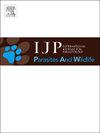Diversity and distribution of helminth communities of the rodent Akodon montensis Thomas, 1913 (Rodentia: Cricetidae: Sigmodontinae) in preserved and altered environments in the Atlantic Forest, Brazil
IF 2.2
3区 医学
Q3 ECOLOGY
International Journal for Parasitology-Parasites and Wildlife
Pub Date : 2025-06-19
DOI:10.1016/j.ijppaw.2025.101106
引用次数: 0
Abstract
The conversion of natural landscapes into agricultural and urban areas results in vegetation loss and habitat fragmentation, affecting biodiversity and favoring generalist species, such as Akodon montensis. This rodent species acts as a reservoir for zoonotic agents and harbors various parasites, including helminths, which are important indicators of environmental changes. The present study analyzed the structure, composition, and diversity of the helminth community of A. montensis in the Atlantic Forest, considering four locations in the state of São Paulo, Brazil. We calculated parasitological parameters (abundance, intensity and prevalence of infection) for each helminth species and evaluated helminth diversity within and between each individual host. In addition, we assessed the influence of type of environment (preserved forest or altered matrix) and host characteristics (sex and body size) on parasitological parameters of helminth species and on helminth diversity. A total of 64 individuals of A. montensis were analyzed, of which 60.9 % were infected with at least one helminth species. Nine species were collected, including eight nematodes and one cestode. No influence of the type of environment and host characteristics was observed on the parasitological parameters of some helminth species (e.g., Protospirura numidica criceticola, Rodentolepis akodontis, Stilestrongylus eta and Syphacia (Syphacia) carlitosi) and on the diversity of helminths within each individual host. A low effect of the type of environment on the diversity of parasites was observed among infracommunities. As an opportunistic species, A. montensis can exploit a wide range of resources and environmental conditions, making it less susceptible to variations in parasite diversity across habitats. These findings reinforce the importance of investigating parasite fauna in different landscapes to understand the impacts of anthropization on host-parasite interactions.

巴西大西洋森林保存环境和改变环境中啮齿动物(啮齿目:蟋蟀科:斑齿目)寄生虫群落的多样性和分布
将自然景观转变为农业和城市地区会导致植被丧失和栖息地破碎化,影响生物多样性,并有利于像Akodon montensis这样的多面手物种。这种啮齿类动物是人畜共患病原体的储存库,并藏有各种寄生虫,包括蠕虫,它们是环境变化的重要指标。本研究以巴西圣保罗州的四个地点为研究对象,分析了大西洋森林中A. montensis蠕虫群落的结构、组成和多样性。我们计算了每种寄生虫的寄生虫学参数(丰度、强度和感染流行率),并评估了每个个体宿主内部和宿主之间的寄生虫多样性。此外,我们还评估了环境类型(保留森林或改变基质)和寄主特征(性别和体型)对蠕虫种的寄生参数和寄生虫多样性的影响。共捕获孟氏弓形螨64只,其中60.9%至少感染一种寄生虫。共采集到线虫8种,囊虫1种。环境类型和寄主特征对一些蠕虫物种(如numidica cricticola、roentolepis akodontis、Stilestrongylus eta和Syphacia carlitosi)的寄生参数和每个寄主内蠕虫的多样性没有影响。环境类型对下层群落寄生虫多样性的影响较小。作为一种机会主义物种,孟氏弓形虫可以利用广泛的资源和环境条件,使其不易受不同栖息地寄生虫多样性变化的影响。这些发现加强了在不同景观中调查寄生虫动物群的重要性,以了解人类化对宿主-寄生虫相互作用的影响。
本文章由计算机程序翻译,如有差异,请以英文原文为准。
求助全文
约1分钟内获得全文
求助全文
来源期刊

International Journal for Parasitology-Parasites and Wildlife
Medicine-Infectious Diseases
CiteScore
3.80
自引率
5.60%
发文量
113
审稿时长
45 days
期刊介绍:
The International Journal for Parasitology: Parasites and Wildlife (IJP-PAW) publishes the results of original research on parasites of all wildlife, invertebrate and vertebrate. This includes free-ranging, wild populations, as well as captive wildlife, semi-domesticated species (e.g. reindeer) and farmed populations of recently domesticated or wild-captured species (e.g. cultured fishes). Articles on all aspects of wildlife parasitology are welcomed including taxonomy, biodiversity and distribution, ecology and epidemiology, population biology and host-parasite relationships. The impact of parasites on the health and conservation of wildlife is seen as an important area covered by the journal especially the potential role of environmental factors, for example climate. Also important to the journal is ''one health'' and the nature of interactions between wildlife, people and domestic animals, including disease emergence and zoonoses.
 求助内容:
求助内容: 应助结果提醒方式:
应助结果提醒方式:


